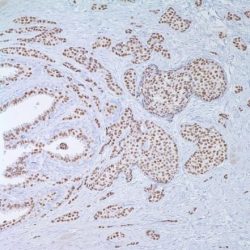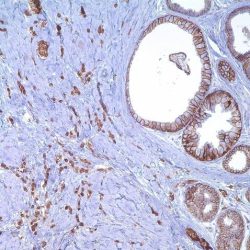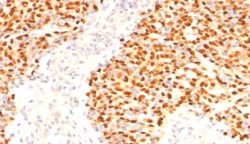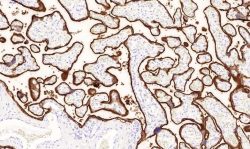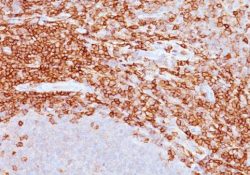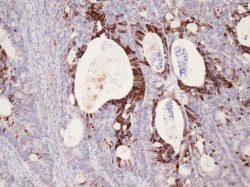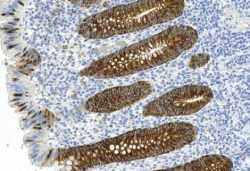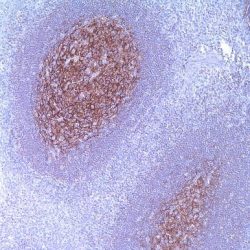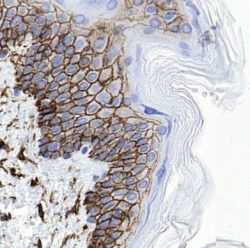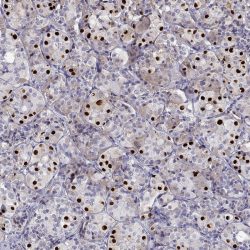Category: monoclonal
Showing 361–380 of 478 results
فیلتر ها-
آنتی بادیهای ایمونوهیستوشیمی
آنتی بادی CD43 کلون SPN/3388 برند Patho Sage
Rated 0 out of 5Specification:
It recognizes a cell surface glycoprotein of 95/115/135kDa (depending upon the extent of glycosylation), identified as CD43. 70-90% if T-cell lymphomas and from 22-37% of B-cell lymphomas express CD43. No reactivity has been observed with reactive B-cells. So a B-lineage population that co-expresses CD43 is highly likely to be malignant lymphoma, especially a low grade lymphoma, rather than a reactive B-cell population. When CD43 antibody is used in combination with anti-CD20, effective immunophenotyping of the lymphomas in formalin-fixed tissues can be obtained. Co-staining of a lymphoid infiltrate with anti-CD20 and anti-CD43 argues against a reactive process and favors a diagnosis of lymphoma.
Immunogen:
Recombinant full-length human SPN protein
Presentation:
Purified antibody from bioreactor concentrates by protein A/G. Prepared in 10mM PBS with 0.05% BSA and 0.05% Azide.
-
آنتی بادیهای ایمونوهیستوشیمی
آنتی بادی WT1 (Wilms Tumor) کلون WT49 برند Patho Sage
Rated 0 out of 5Specification:
The WT1 gene, identified as a tumor suppressor gene located at 11p13, is involved in the development of Wilms’ tumor. The WT1 gene encodes a transcription factor with four DNA-binding zinc fingers at the C terminus. In vitro studies showed that WT1 suppresses or activates a number of genes, including those for PDGF-A chain, EGF receptor, CSF-1, IGF-II, IGF-I receptor, RAR-α, c-myc, bcl-2 and WT1 itself. Immunohistochemically, WT1 is detected in the nucleus of tumor cells of Wilms’ tumor and mesothelioma; therefore, WT1 has traditionally been used as a diagnostic marker for these tumors. Recent reports showed that other types of cancers, such as ovarian serous cancers and rhabdomyosarcomas also express WT1.
Presentation:
Tissue culture supernatant containing 15mM sodium azide
-
آنتی بادیهای ایمونوهیستوشیمی
آنتی بادی PR (Progesterone Receptor) کلون ZR4 برند Patho Sage
Rated 0 out of 5Specification:
The progesterone receptor (PgR) is an estrogen regulated protein. It has been proposed that expression of PgR determination indicates a responsive estrogen receptor (ER) pathway, and therefore, may predict likely response to endocrine therapy in human breast cancer. A number of studies have shown that PgR determination provides supplementary information to ER, both in predicting response to endocrine therapy and estimating survival. PgR has proved superior to ER as a prognostic indicator in some studies.
Immunogen:
Recombinant protein encoding human progesterone receptor 412-526 aa
Presentation:
Tissue culture supernatant with 0.2% BSA and 15mM sodium azide
-
آنتی بادیهای ایمونوهیستوشیمی
آنتی بادی SOX10 کلون 1074 برند Patho Sage
Rated 0 out of 5Specification:
Recognizes a protein of -55kDa, identified as SOX I 0. This MAb is highly specific and does not cross-react with other members of the SOX-family. SOX genes comprise a family of genes that are related to the mammalian sex-determining gene SRY. These genes similarly contain sequences that encode for the HMG-box domain, which is responsible for the sequencespecific DNA binding activity. SOX-10 is a sensitive marker of melanoma, including conventional, spindled,and desmoplastic subtypes. It is expressedby metastatic melanomas and nodal capsular nevusin sentinel lymph nodes, but notby other lymph node componentssuch asdendritic cells, which usually express S I 00protein. Commonly used melanoma markers, such as anti-HMB-45andanti-Melan-A, are poorly expressed in desmoplasticmelanomas while SOX-10 is moderately to strongly expressed in desmoplastic melanomas. SOX- 10 is considered as a very reliable marker for recognizing residual desmoplastic melanomas. In normal tissues, it is expressed in Schwann cells, melanocytes, and myoepithelial cells of salivary, bronchial and mammary glands. SOX-I 0 expression is also observed in mast cells.
Immunogen:
Recombinant fragment (155 Amino residues between aa 100-300) of human SOX10 protein
Presentation:
Bioreactor Concentrate with 0.05% Azide
-
آنتی بادیهای ایمونوهیستوشیمی
آنتی بادی CA19-9 کلون 121Sle برند Patho Sage
Rated 0 out of 5Specification:
CA19-9 antigen is highly expressed in gastrointestinal (gastric, pancreatic, and colonic) adenocarcinomas and salivary gland mucoepidermoid carcinomas. Anti-CA19-9 antibody is usually not reactive with breast, kidney, and prostate carcinomas.
Immunogen:
Immunoprecipitated obtained after immunodiffusion of MAb 19-9 and mucins isolated from an ovarian cyst of a 0Le(a+b-) patient
Presentation:
Bioreactor Concentrate with 0.05% Azide
-
آنتی بادیهای ایمونوهیستوشیمی
آنتی بادی CD99 کلون 12E7 برند Patho Sage
Rated 0 out of 5Specification:
Recognizes a sialo glycoprotein of 27-32kDa, identified as CD99, or MIC2 gene product, or E2 antigen. MIC2 gene is located in the pseudo-autosomal region of the human X and Y chromosome. MIC2 gene encodes two distinct proteins, which are produced by alternative splicing of the CD99 gene transcript and are identified as bands of 30 and 32kDa (p30/32). Although its function is not fully understood, CD99 is implicated in various cellular processes including homotypic aggregation of T cells, upregulation of T cell receptor and MHS molecules, apoptosis of immature thymocytes and leukocyte diapedesis. CD99 is expressed on the cell membrane of some lymphocytes, cortical thymocytes, and granulosa cells of the ovary. Most pancreatic islet cells, Sertoli cells of the testis, and some endothelial cells express this antigen. Mature granulocytes express very little or no CD99. MIC2 is strongly expressed on Ewing’s sarcoma cells and primitive peripheral neuroectodermal tumors.
Immunogen:
Human acute lymphocytic leukemia T-cells
Presentation:
Bioreactor Concentrate with 0.05% Azide
-
آنتی بادیهای ایمونوهیستوشیمی
آنتی بادی P120 (Delta Catenin 1) کلون 15D2 برند Patho Sage
Rated 0 out of 5Specification:
The catenin’s alpha, beta, and gamma are proteins which bind to the highly conserved, intracellular cytoplasmic tail of Ecadherin. Together, the catenin/cadherin complexes play an important role mediating cellular adhesion. Catenin, a 102 kDaprotein, was initially described as an E-cadherin-associated protein and has been shown to associate with other members of the cadherin family N-cadherin and P-cadherin. The 92 kDa catenin associates with the cytoplasmic portion of E-cadherin which is necessary for the function of E-cadherin as an adhesion molecule. Catenin has also been found in complexes with the tumor suppressor protein APC. Catenin, also known as plakoglobin, is an 82 kDa protein that binds with catenin and Ncadherin. A related protein, p120, exhibits sequence homology with the catenins at four discreet domains. p120 not only serves as a substrate for Src but is also found in E-cadherin complexes containing catenins. p120 (15D2): sc-23872. Immunoperoxidase staining of formalin fixed, paraffin-embedded human breast tissue showing membrane and cytoplasmic localization.
Presentation:
Each vial contains 200 µg IgG in 1.0 ml of PBS with < 0.1% sodium azide 1 and 0.1% gelatin
-
آنتی بادیهای ایمونوهیستوشیمی
آنتی بادی LMO2 کلون 1A9-1 برند Patho Sage
Rated 0 out of 5Specification:
The LIM-only (LMO) proteins, LMO1 and LMO2, are nuclear factors that are characterized by a conserved LIM domain. The LIM domain consists of a cysteine-rich zinc-binding motif that is present in a variety of transcription factors, including the LIM homeobox (LHX) proteins expressed in the central nervous system and involved in cell differentiation. LMO1 and LMO2 are expressed in the adult CNS in a cell type-specific manner, where they are differentially regulated by neuronal activity and are involved in regulating the cellular differentiated phenotype of neurons. LMO2 lacks a specific DNA-binding homeobox domain but rather assembles into transcriptional regulatory complexes to mediate gene expression by interacting with the widely expressed nuclear LIM interactor (NLI). NLI, known also as CLIM-1, and the related protein CLIM2 facilitate the formation of heteromeric LIM complexes and also enhance the nuclear retention of LIM proteins. LMO2 and the related protein LMO4 are expressed in thymic precursor cells. LMO4 is also expressed in mature T cells, cranial neural crest cells, somite, dorsal limb bud mesenchyme, motor neurons, and Schwann cell progenitors.
Immunogen:
Recombinant LMO2 of human origin
Presentation:
Each vial contains 200 µg IgG1 in 1.0 ml of PBS with < 0.1% sodium azide and 0.1% gelatin
-
آنتی بادیهای ایمونوهیستوشیمی
آنتی بادی Neurofilament 70/200 kDa کلون 2F11 برند Patho Sage
Rated 0 out of 5Specification:
Anti-Neurofilament antibody stains an antigen localized in several neural, neuroendocrine, and endocrine tumors. Neuromas, ganglioneuromas, gangliogliomas, ganglioneuroblastomas and neuroblastomas stain positively for neurofilament. Neurofilaments are also present in paragangliomas and adrenal and extra-adrenal pheochromocytomas. Carcinoids, neuroendocrine carcinomas of the skin, and oat cell carcinomas of the lung also express neurofilament.
Presentation:
Anti-Neurofilament is a mouse monoclonal antibody from supernatant diluted in tris buffered saline, pH 7.37.7, with protein base, and preserved with sodium azide
-
آنتی بادیهای ایمونوهیستوشیمی
آنتی بادی CD4 کلون 3619R برند Patho Sage
Rated 0 out of 5Specification:
Recognizes a protein of 55kDa, identified as CD4. It is a membrane glycoprotein of T lymphocytes that interacts with major histocompatibility complex class II antigens and is also a receptor for the human immunodeficiency virus. This protein is expressed not only in T lymphocytes, but also in B cells, macrophages, and granulocytes. The protein functions to initiate or augment the early phase of T-cell activation, and may function as an important mediator of indirect neuronal damage in infectious and immune-mediated diseases of the central nervous system. The majority of peripheral T-cell lymphomas are derived from the T-helper/regulatory cell subset so that most mature T-cell neoplasms are CD4+/CD8-. Anti-CD4 is used in the immunohistochemical staining of lymphoproliferative disorders to evaluate tumors with CD4 aberrant expression.
Immunogen:
Recombinant fragment (around aa 216-396) of human CD4 protein (exact sequence is proprietary)
Presentation:
Tissue culture supernatant containing 15mM sodium Azide as a preservative
-
آنتی بادیهای ایمونوهیستوشیمی
آنتی بادی MyoD1 کلون 5.8A برند Patho Sage
Rated 0 out of 5Specification:
Recognizes a phosphor-protein of 45kDa, identified as MyoD1. The epitope of this MAb maps between amino acid 180-189 in the C-terminal of mouse MyoD1 protein. It does not cross react with Myogenin, Myf5, or Myf6. Antibody to MyoD1 labels the nuclei of myoblasts in developing muscle tissues. MyoD1 is not detected in normal adult tissue but is highly expressed in the tumor cell nuclei of rhabdomyosarcomas. Occasionally nuclear expression of MyoD1 is seen in ectomesenchymoma and a subset of Wilm’s tumors. Weak cytoplasmic staining is observed in several non-muscle tissues, including glandular epithelium and in rhabdomyosarcomas, neuroblastomas, Ewing’s sarcomas and alveolar soft part sarcomas.
Immunogen:
Recombinant mouse MyoD1 protein
Presentation:
Bioreactor Concentrate with 0.05% Azide
-
آنتی بادیهای ایمونوهیستوشیمی
آنتی بادی Plap (Placental Alkaline Phosphatase) کلون ALP/81112R برند Patho Sage
Rated 0 out of 5Specification:
Reacts with a 70kDa membrane-bound isozyme of Placental Alkaline Phosphatase (PLAP) occurring in the placenta during the 3rd trimester of gestation. It is highly specific for PLAP and shows no cross reaction with other isozymes of alkaline phosphatase. Anti-PLAP reacts with germ cell tumors and can discriminate between these and other neoplasms. Somatic neoplasms e.g. breast, gastrointestinal, prostatic and urinary cancers may also immunoreact with antibodies to PLAP. Anti PLAP positive in conjunction with anti-keratin positive, but they regularly fail to stain with anti-EMA, whereas most carcinomas stain with anti-EMA. Anti-PLAP as been useful in the diagnosis of gestational trophoblastic disease.
Presentation:
Bioreactor Concentrate with 0.05% Azide
-
آنتی بادیهای ایمونوهیستوشیمی
آنتی بادی CD21 کلون CR2/2754 برند Patho Sage
Rated 0 out of 5Specification:
Recognizes a protein of 140kDa, which is identified as the complement receptor 2 (CR2) or CD21. This protein is expressed strongly on mature B cells, follicular dendritic cells and weakly on immature thymocytes and t lymphocytes. In B-cells ontogeny, CD21 appears after the pre-B-stage, is maintained during peripheral B-Cell development and is lost upon terminal differentiation into plasma cells. CD21 expression is also gradually lost after stimulation of B cells in vitro. CD21 functions as receptor for C3d. C3dg and IC3b complement components, for EBV and for IFNalpha. CD21 binds to CD23 and associates with CD19, CD81, and Leu13 to form a large signal-transduction complex involved in B cell activation.
Immunogen:
Recombinant fragment (around aa142-240) of human CR2 (CD21) protein (exact sequence is proprietary)
Presentation:
Bioreactor Concentrate with 0.05% BSA and 0.05% Azide
-
آنتی بادیهای ایمونوهیستوشیمی
آنتی بادی Cytokeratin 18 کلون DC10 برند Patho Sage
Rated 0 out of 5Specification:
Keratin 18, which belongs to the type A (acidic) subfamily of low molecular weight keratins exists in combination with keratin 8. It was reported that tissues from gastrointestinal tract are positive for both keratin 8 and 18 but do not contain keratin 14. Tissues from gastrointestinal tract, respiratory tract and urogenital tract, as well as endocrine and exocrine tissues and mesothelial cells are positive for keratin 18. Clone DC10 recognizes a variety of simple epithelia including glandular epithelium but not stratified squamous epithelia.
Immunogen:
Human breast cancer PMC 42 cells
Presentation:
Keratin 18 is a purified mouse monoclonal antibody, 0.2% BSA and 15mM sodium azide.
-
آنتی بادیهای ایمونوهیستوشیمی
آنتی بادی CD43 کلون DF-T1 برند Patho Sage
Rated 0 out of 5Specification:
The anti-CD43 antibody recognizes a cell surface glycoprotein of 95/115/135kDa (depending upon the extent of glycosylation), identified as CD43. 70-90% of T-cell lymphomas and from 22-37% of B-cell lymphomas express CD43. No reactivity has been observed with reactive B-cells. So, a B-lineage population that co-expresses CD43 is highly likely to be a malignant lymphoma, especially a low-grade lymphoma, rather than a reactive B-cell population. When CD43 antibody is used in combination with anti-CD20, effective immunophenotyping of the lymphomas in formalin-fixed tissues can be obtained. Co-staining of a lymphoid infiltrate with anti-CD20 and anti-CD43 argues against a reactive process and favors a diagnosis of lymphoma.
Immunogen:
KG1 cells (myoblast cell line)
Presentation:
Bioreactor Concentrate with 0.05% Azide
-
آنتی بادیهای ایمونوهیستوشیمی
آنتی بادی Cytokeratin 20 کلون E19-1 برند Patho Sage
Rated 0 out of 5Specification:
Keratin 20 / cytokeratin20 (CK20) is a type-I keratin which is primarily expressed in gastric and intestinal epithelium, urothelium, and Merkel-cells. CK20 is expressed in adenocarcinomas of the colon, stomach, pancreas and the bile system. CK20 is also present in mucinous ovarian tumours, transitional-cell and Merkel-cell carcinomas.
Immunogen:
Peptide derived from C-terminal region of human cytokeratin 20
Presentation:
monospecific rabbit clonal antibody in 20 mM Tris-HCl, pH 8.0 with 20 mg/ml BSA and 0.05% NaN3
-
آنتی بادیهای ایمونوهیستوشیمی
آنتی بادی EMA (Epithelial Membrane Antigen /MUC-1) کلون E29 برند Patho Sage
Rated 0 out of 5Specification:
Anti-EMA antibody is a useful marker for staining many carcinomas. It stains normal and neoplastic cells from various tissues, including mammary epithelium, sweat glands and squamous epithelium. Hepatocellular carcinoma, adrenal carcinoma and embryonal carcinomas are consistently EMA negative, so keratin positivity with negative EMA favors one of these tumors. EMA is frequently positive in meningioma, which can be useful when distinguishing it from other intracranial neoplasms, e.g. Schwannomas. The absence of EMA can also be of value since negative EMA staining is characteristic of some tumors including adrenal carcinoma, seminomas, paraganglioma and hepatoma.
Immunogen:
Delipidated extract of human milk fat globule membranes
Presentation:
Bioreactor Concentrate with 0.05% Azide
-
آنتی بادیهای ایمونوهیستوشیمی
آنتی بادی CD2 کلون EP222 برند Patho Sage
Rated 0 out of 5Specification:
CD2 is one of the earliest T-cell lineage restricted antigens to appear during T-cell differentiation and only rare CD2+ cells can be found in the bone marrow. Anti-CD2 is a pan-T-cell antigen marker. Anti-CD2 is therefore useful for the identification of virtually all normal T-lymphocytes. It is also very useful in the assessment of lymphoid malignancies as it is expressed in the majority of precursor and mature T-cell lymphomas and leukemias. As with other pan-T-cell antigens, CD2 may be aberrantly deleted in some neoplastic T-cell populations, especially peripheral T-cell lymphomas. When combined with antiCD25, antiCD2 may assist in the identification of systemic macrocytosis and mastocyte leukemia.
Immunogen:
A human CD2 recombinant protein
Presentation:
Antibody in Phosphate Buffered Saline, pH 7.2, with 1% BSA and <0.1% Sodium Azide
-
آنتی بادیهای ایمونوهیستوشیمی
آنتی بادی CD21 کلون EP3093 برند Patho Sage
Rated 0 out of 5Specification:
CD21 antigen is an integral membrane glycoprotein of molecular weight 140 kD. Anti-CD21 is useful in the identification of follicular dendritic cell matrix found in normal lymph nodes and tonsillar tissue. This antibody also labels follicular dendritic cell tumor/sarcomas. The antigen is absent on T-lymphocytes, monocytes, and granulocytes. Associated products: CD35, Follicular Dendritic Cell
Presentation:
Anti-CD21 is a rabbit monoclonal from tissue culture supernatant diluted in tris buffered saline, pH 7.3-7.7, with protein base, and preserved with sodium azide
-
آنتی بادیهای ایمونوهیستوشیمی
آنتی بادی P16-INK4 کلون G175-405 برند Patho Sage
Rated 0 out of 5Specification:
Cyclins and cyclin-dependent kinases (cdks) form active complexes that regulate key events during the progression of the cell cycle and are evolutionarily highly conserved. The p16 protein has been identified as a specific inhibitor of cdk4 because it blocks cdk4 substrate phosphorylation. p16 inhibits cdk4 dependent phosphorylation of the tumor suppressor retinoblastoma protein (Rb) and Rb related proteins, p107 and p130. The biochemical properties of p16 suggest that it may be a tumor suppressor gene product. Recently a gene cloned from the short arm of human chromosome 9, Multiple Tumor Suppressor 1 (MTS1) has been identified as the gene for p16. The gene, now also known as the CDKN2 gene, has been found to be mutated in a very high percentage of tumors, including 75% of melanoma cell lines.
Presentation:
Monoclonal antibody purified from tissue culture supernatant or ascites by affinity chromatography. Aqueous buffered solution containing BSA, goat serum, and ≤0.09% sodium azide


